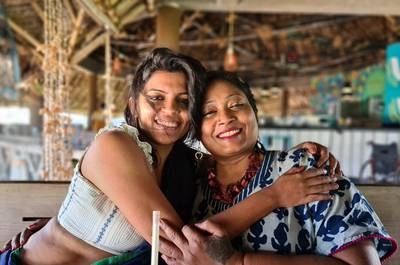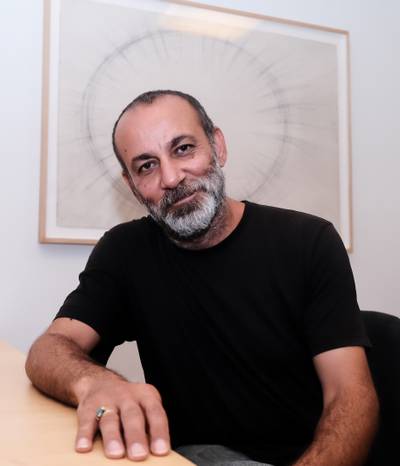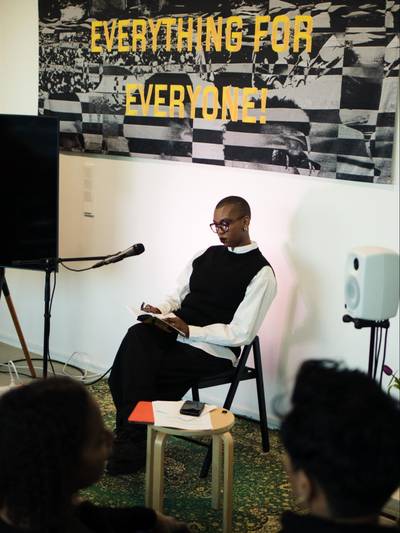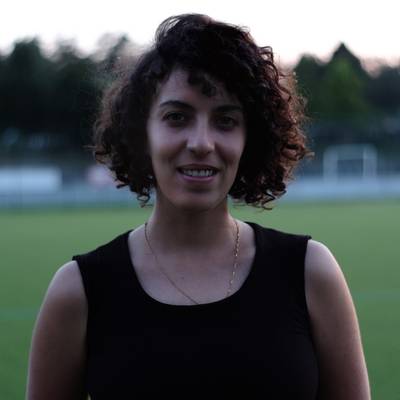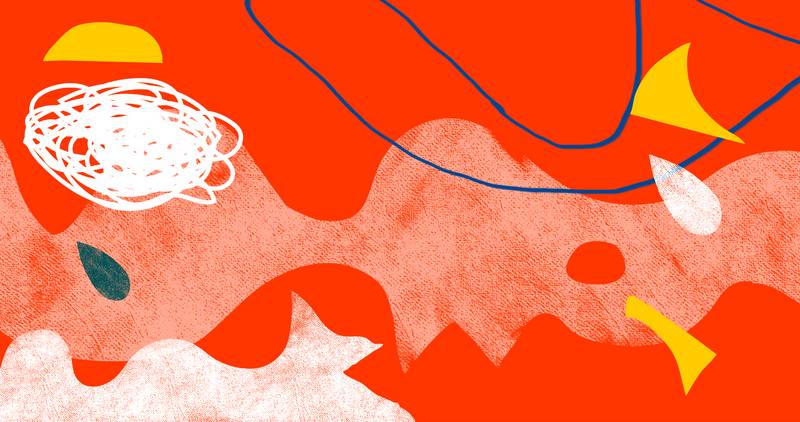

An Paenhuysen is a curator, art critic and educator living in Berlin. She loves blogging on art and started in 2020 the publishing project AAAAA PPPPP Publishing. An is the director of the art project space The House of the Deadly Doris.
It’s easy to remember when I met Eleni Tsitsirikou. It was on the day of my arrival from Berlin to Helsinki for my curatorial residency at Helsinki International Artist Programme (HIAP). On Wednesday, 1 November 2017, I felt nervous looking for the entrance of Kaapeli, the Cable Factory. But there was Eleni waiting for me with a welcoming smile. Since then, throughout the residency, she was the person that I could turn to, making me feel at home. If there is a heart to an organisation, it would be Eleni for HIAP. But what’s the official name for her position? It’s the first question I ask her when I zoom in to talk, this time from Belgrade and Eleni is in home office in Helsinki.
ELENI: Nowadays, my title is “Residency Manager”. As a Residency Manager I coordinate the residency activities and work together with two colleagues, who are mostly interning. We are the hosting team. Previously, there have been different formats of running this kind of work, in a group or individually. Now we do it in a team, which means that my colleagues and sometimes also I are responsible for the moment of welcoming.
AN: Is this “moment of welcoming” also special to you?
Yes, preparing for a residency is a long process, both for the resident and the hosting part. Although the communication starts a few months in advance, the moment of arrival is crucial. It’s the time when abstract names and writers become faces, this is the moment you get to really meet. I think that taking the time to welcome the new resident has been also an exciting moment of my work, one of the motivating aspects… Everyone is different and this diversity excites me.
Can you relate to this moment of arrival?
I myself am a foreign person in Finland. Being a foreigner and arriving at an unknown place is something that I have experienced a few times in my life. Because of this, I believe that I can empathise and put myself in that position also in my work. I know there is a lot of information to communicate and it might be overwhelming for the artist or curator. So it’s about acknowledging that in this moment of arrival the other is in a disorienting position, to respect that and make them feel comfortable and welcome.
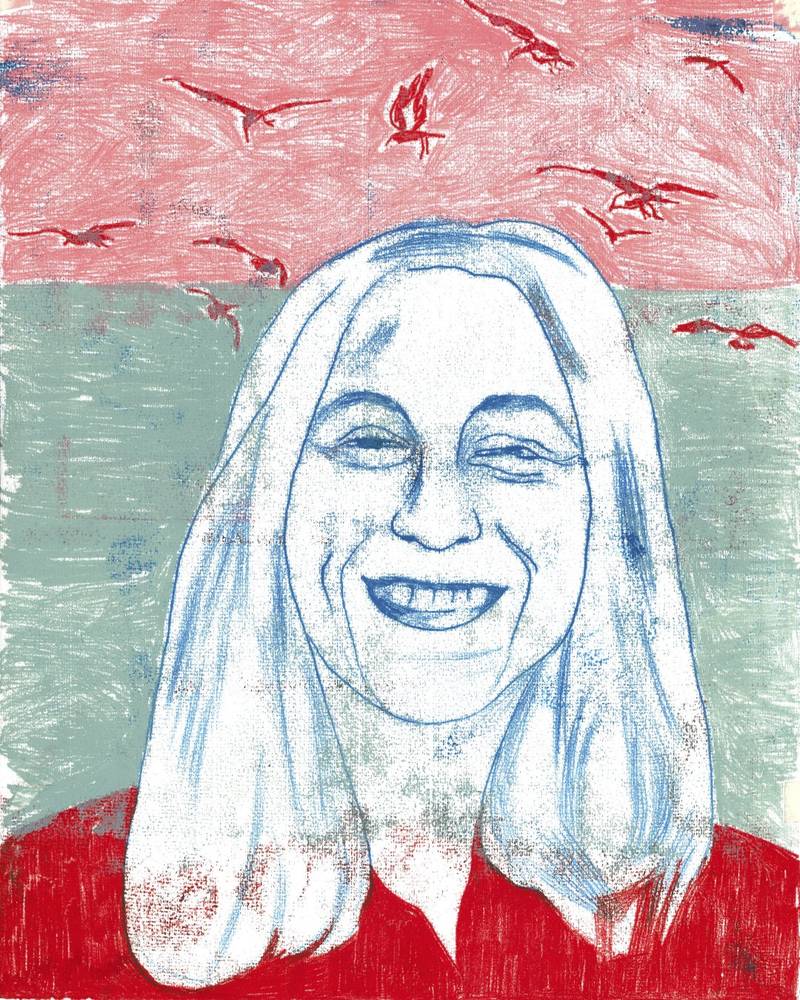

Portrait of Eleni Tsitsirikou by Athanasía Aarniosuo
How do you do that?
It has to do a lot with the character of the person on both sides. In most cases, I try to be communicative, responsive and maintain communication because if you are arriving at a new place, there is usually this need to communicate. Upon arrival, even though I need to mediate a set of things in a certain time frame, I do take the time without calculating too much.
So, that means you’re not in a rush…
Yes, I try to be really present there…. Even during the pandemic, we never did the welcoming online. We were always there while taking all the precautions. The presence is important. It’s also about trying to read and feel the needs of the moment. When it comes to these practical aspects at the beginning of a residency, some people are more independent, while others need more guidance. Others might be very tired. You need to be able to see this. That’s why I say “to read”.
Last week, I had some international guests coming over for an exhibition. It was fun but I must say that I was also relieved when the hosting ended after five days. How is it for you to be a permanent host?
One of the developments at HIAP over the past few years is that previously there used to be much more short-term residencies. There were times when HIAP hosted over 150 residents every year. Some of them you didn’t really get to see much or even meet them in certain cases. Around 2014, we started lowering the number of residencies by focusing on long-term stays and created these cycles in the year, we call them “seasons”, in an effort to have the residents arriving more or less at the same time and experiencing the activities within each residency season together. There is no constant flow anymore. I think this has helped us a lot as a team in creating a real community. This benefited the residents but also us, as a team. If people are coming and going continuously, there is no sense of community.
You mentioned before that you went through different roles at HIAP. It’s nice that one can grow inside an institution. How did you get started at HIAP?
In 2008, I moved to Finland and had to start from zero. I came to Helsinki for other reasons than work or study (laughs), so love, obviously… and there were no professional connections. I also didn’t have knowledge of the language.
The presence is important. It’s also about trying to read and feel the needs of the moment. When it comes to these practical aspects at the beginning of a residency, some people are more independent, while others need more guidance. Others might be very tired. You need to be able to see this.
Now you even seem to have a Finnish accent!
Could be… (laughs) I started learning the language, I took courses. And I started immediately looking for jobs in the cultural field. I have a bachelor in Archeology and History of Art from Greece, and later I did a Masters in Museology in Germany. After the end of my studies, I returned to Greece and worked in an Art Foundation, which also had a space for exhibitions. So… back in 2008, having work experience abroad, and while I was searching for a job in the field, I realised that the Finnish art scene was not as international as I thought it would be.
Did it change a lot?
Quite a bit I think. Of course, now I also know more people, I guess I see it from a different perspective, but yes, I think some things have changed indeed. The Finnish language was also a barrier. I had discovered HIAP in my searches for potential workplaces. When I had grown in the language, I took a course that combined language and preparation towards work life, meaning an internship. I applied for an internship HIAP, I was invited to an interview, got selected, and so it started. Soon, it seemed possible for me to continue and I got more responsibilities. I passed through all the phases of supported employment that are possible in Finland. After the internship followed a different model, in which salary is covered partly by the employer, and partly by the employment office.
What did you do at HIAP?
After my internship, I was given new responsibilities, and I became responsible for the gallery that HIAP used to run in the Cable Factory. And I was also involved in our very first European partnership project. Then a critical moment came when there was the decision to stop running the Cable Gallery and to focus more on enlivening the activities and experience in the HIAP premises on the island. Also, the European project was finished. I really appreciate that the former director, Jaakko Rustanius, gave me the opportunity to discuss. We talked about how I see myself in the future, which is something that does not necessarily happen in an organisation. I was interested in project management so it made more sense to continue in this direction.
You entered the world of project management…
Yes, that is only after we had secured the funding of a five-year-long European collaboration project. Parallel to this, I also worked on another partnership project with a focus on creating networks in the Nordic & Baltic region. That, at some point, became too overwhelming in terms of workload. Juha Huuskonen was already the director of HIAP then, and there was a moment when we sat down and discussed how realistic it was to continue like that. I really appreciate that we had such a conversation and also acted towards finding a concrete solution to this. We decided that I would need to leave one project and continue the other. Then I also worked as an Event Manager since we wanted to see how we can work with Gallery Augusta, the HIAP gallery on the island, and open up more towards other actors from the local scene. Eventually, a few years ago, I switched into being a Residency Manager.
My greatest concern was that on the island there are no random encounters, which you had a lot in Kaapeli as a lot of other cultural organisations were based in the building. On the island, someone has to make the decision to come to meet you. On the other hand, those that come, really engage and they truly want to meet you. In that sense, the encounter is more intense.
Before that, you were not dealing with the artists?
Mostly with the residents that were part of the projects I worked with. Now, in this current role, I work in a team, the so-called hosting team. I’m a supervisor and also an educator in that sense, because I initiate them to the work processes of our organisation, guide them, follow up on what they do, and closely collaborate with them. As a residency manager, I have the overview and general responsibility of the residency cycles (seasons), the Open Studios events, the weekly get-togethers between residents and the HIAP team. Plus the maintenance, I’m responsible for everything that relates to the maintenance of the premises in which HIAP operates, the spaces in Suomenlinna and Cable Factory.
HIAP started out in 1998 in Kaapeli, and in 2010, it also came to Suomenlinna. Island life is quite particular. How is it for you to work on an island?
It is a very distinct part of my daily work routine and such a unique part as well. At the very beginning of my work, when we decided to move the offices from Kaapeli to Suomenlinna, I was a bit sceptical about it. My greatest concern was that on the island there are no random encounters, which you had a lot in Kaapeli as a lot of other cultural organisations were based in the building. On the island, someone has to make the decision to come to meet you. On the other hand, those that come, really engage and they truly want to meet you. In that sense, the encounter is more intense. Also, I love the sea. That’s another important factor in me being happy with my work. I guess it’s also that the island has this contrast: it’s isolated but also open. It’s surrounded by the sea. It’s potentially open to every direction and the sea connects rather than isolates it.
Nature is also very connective, rather than the city, which can make me feel so disconnected.
It’s a luxury to have the landscape around you. Sometimes I take my break on the rocks, my lunch by the sea. I should do that more often!
And then there is the ferry ritual. You have to live on the ferry schedule.
Yes, it’s a forced slowing down, acknowledging this dependency. Also for bringing stuff in, for carrying materials with you, it’s a good limitation because it forces you to see this reality, to think twice about what you get there because you have to take it back or know how to dispose of it.
Since you started working at HIAP… how long have you been there?
Ten … no, twelve years…
Has there been a change in how art residencies are perceived, how they are set up?
Yes and no. Certain aspects, in my opinion, have remained the same, or certain values, certain goals why an art residency is there as a format. Others have changed, or maybe we, who work there, and also the artists and art professionals who use the residency as a tool for their work and development, have become more aware or we were aware but not discussing those topics. A main principle of the residency is that it offers the time and space for concentrated and focused work, for reflection, for open-ended creative work (at least at HIAP, the open-ended element is an important one), for dialogue, networking and connection with fellow residents and other professionals who visit or engage in the activities. It offers time for developing, trying out or reconfiguring, depending on what phase you are in when you enter the residency. What has changed, is the effort to offer a better-supported residency, financially but also in terms of structures. Then, a more conscious move towards changing practices that relate to food, energy and travel with the aim to reduce the organisation’s use of fossil fuels and carbon footprint. There is also the slowing down. From both sides, we’ve become more aware of the need to slow things down, to work more with long-term relationships and longer periods of time to allow things to happen and not be fast-paced. And then the sense of community, there has been more effort to highlight its importance.
What sense of community do you mean?
In the organisation, meaning the residency community, but also beyond. There is more focus on collaboration with networks that are closer. We do have collaborations that reach far away but there is more awareness towards the neighbouring ones, like Russia, the Baltic, also in the context of slow travelling and not flying too much. Then there is the question of diversity. Who comes to our residency? Is it only Europeans? There is an effort to open it up. Also in our own team, there are similar questions about a diverse working environment, in terms of age groups and backgrounds of people. Previously, we used to have an in-house curator. For the last few years every season, we work with a different art professional. This allows us and our residents to work with independent curators, curators from institutions, curators from abroad, curators from Finland…
Where do you personally find motivation in your work as Residency Manager?
I realise that one of my strengths is communication with people. I genuinely enjoy that and I’m happy I can do that as part of my work. I like to help and support towards realisation of the art works, projects or ideas. What motivates me is that I have this kind of luxury to be there in the background. I enjoy being in the background and making things possible for others, coordinating in order to make things happen.
Often one thinks that the luxury is to be in the spotlight…
This period of focused work, experimentation, and support of the creative process, this kind of attitude, is what motivates me. This luxury, of seeing projects and ideas in their birth. They are being developed as artists are present and even though the actual outcome may come only later when they are gone, it is still exciting to follow. This moment of fragility, when a work is still in its fragile state, is unique to witness. Later it gets presented in an art space or a museum and that is what most people get to experience but in the first phase, not so many…
I don’t travel that much, but I have so many invitations! I could travel the world and there would always be someone there. There is this positive feeling once we cross paths that we could cross paths again one way or another…
That answers my question about why you enjoy working with artists /curators.
Also, the fact that I learnt so much out of this. I keep on learning… the topics, the discussions… There is no same season…. There is no repetition. I mean, of course, there has to be a balance, because I’m also a big supporter and friend of stability.
You work with people who come and go. And you’re the one who stays. Have you become an expert in letting go?
Especially in the first years of work, it was more difficult, as we had a lot more people coming in… Now we have about 30 residents per year, that is a big change for the better. The emotional ups and downs are less. You also connect with some of the people you work with. You could be friends if they would stay for a longer time, you could continue the relationship. I experienced it most sternly if they were from far away countries and we know we will probably never see them again. It rarely happens because I don’t travel that much, but I have so many invitations! I could travel the world and there would always be someone there (laughs). There is this positive feeling once we cross paths that we could cross paths again one way or another… Or if they’re leaving I know that with all these means of communication, it’s easier to stay in touch.
And here we are too, zooming! There are many things I took from my HIAP residency that live on in my own practise, for instance, the idea of “mingling” instead of “networking”.
Networking has this connotation that your goal is to go and meet, like speed dating. Mingling is a more informal, relaxed way of meeting. Besides scheduled on-site or online meetings, we mostly communicate with our residents via email, but we also have our regular Afternoon Coffee get-together once a week. This is a highlight in my work days, and it is really important not only for the work but for the HIAP Community too. There are so many other things that I have going on in the background, but during these two hours every week, I stop and take the time, and I also enjoy it.
